The classification criteria described so far do not depend on the theme itself, but on how the same theme interacts with each card, replacing or modifying the traditional illustrations. In fact, several sample decks shown in this page are inspired by a similar theme, i.e. ethnic groups and civilizations, yet according to their graphic scheme they belong to different typologies.
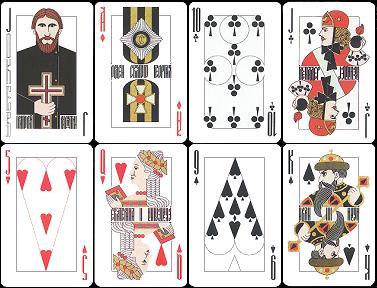
Royal deck, made in China for the Russian market
(manufacturer unknown) |
Although these guidelines are very simple, and can be easily applied to any fancy design, among the great variety of non-standard patterns there are still a few cases which may be looked at as "borderline", such as the sample shown on the left, with Russian historical personages: the pips are Diamonds, Hearts, Spades and Clubs, yet quite elongated, and arranged inside white shapes that recall the same suit sign: this could loosely match either the features of group 1 or those of group 2.
|
Among non-standard patterns there is one more variety, rather different from the ones described above: the so-called
TRANSFORMATION DECKS.

replica of a transformation deck by G.Payer, c.1850 |
They are the most sought for by collectors, but also the least common, because the peculiar illustrations they feature require both the artistic skills and the creative imagination of a talented artist.
Actually, rather few patterns of this kind have ever been created, compared to the enormous number of more generic non-standard editions.
Transformation decks are not necessarily inspired by a particular theme, but in each subject the pips are cleverly disguised by additional illustrations, in which they are integrated as details of the picture. |
Therefore, unlike any other fancy playing card edition, in these decks the most interesting subjects are the pip cards, rather than the courts or the jokers.
The more skilled is the author of the deck, the more the suit signs "disappear", as if camouflaged within the context of each illustration. Especially in early editions (see below), the richness of detail is amazing, even in subjects with few pips. The ones with many pips, instead, are often drawn horizontally.
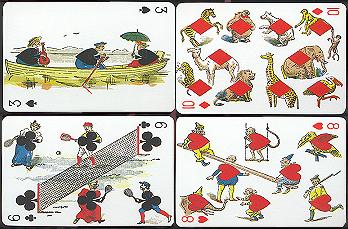
Vanity Fair, reprint by Fournier (Spain) |
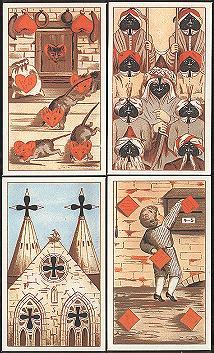
Schwartz Katz, reprint by Il Solleone (Italy) |
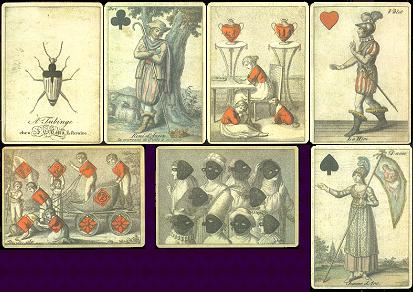
replicas of two decks by J.G. Cotta, printed in 1805 (above) and 1806,
held by the Fournier Museum, Alava-Gasteiz (Spain) |
The sample above is taken from a special edition without court cards made in Nuremberg (Germany) in 1887 for the game of Schwartz Katz ("Black Cat"). The one on its left, instead, is the famous Vanity Fair deck, whose original was printed in 1895 by The U.S. Playing Card Co . Both specimens are modern replicas. |
Transformation cards were first created at the beginning of the 19th century; the 1800s were indeed the golden age of this particular kind of playing cards.
The indisputable master of this form of art was the German publisher J.G. Cotta, active in Tübingen around the early 1800s. Cotta's editions used to feature exquisite monochrome etchings, inspired by a variety of themes; the courts instead had coloured illustrations, with non-standard designs, but their only suit sign was not disguised. |
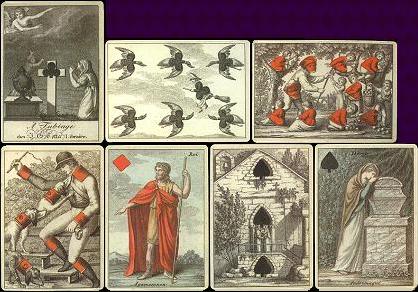 |
go to
OTHER GALLERIES






















or back to

INTRODUCTION
AND HISTORY
|

MULTI-LANGUAGE
GLOSSARY |

THE FOOL &
THE JOKER |

INDEX
TABLE |

REGIONAL
GAMES |

PLAYING CARD
LINKS |